Dive Brief:
- For markets where rooftop solar penetration has begun to exceed 10%, ratemakers must reconsider their net metering policies to ensure that they strike a “reasonable balance” of environmental priorities and fairness to ratepayers, Vote Solar deputy program director Susannah Churchill told an audience at the RE+ conference on Wednesday.
- Southern California Edison, which serves the area surrounding Anaheim, California, pays out more than $1.6 billion to net metering customers, while spending $600 million on discounted electric rates for low-income customers, according to Caroline Choi, senior vice president of corporate affairs for Southern California Edison.
- Walker Wright, vice president of public policy for Sunrun, said the company wanted to move the conversation beyond net metering to what comes next. “We want to electrify the home. We don’t want to argue about the value of an electron exported to the grid at 3:00 in the afternoon on a Tuesday,” he said.
Dive Insight:
Participants in an RE+ panel on ratemaking trends generally agreed that the time for net metering policies has passed in many states. But finding consensus around what should come next could prove challenging.
“Here in California, we are in a period of relatively extreme rate inflation,” said Matt Baker, director of the Public Advocates Office for the state of California. Rates have increased some 50-80% in the San Diego region, and Baker said his office had determined that net metering was responsible for 15-25% of that increase. In some cases, he said, these increased rates have deterred California homeowners from taking steps such as installing heat pumps, which threatens the state’s overall climate goals.
“We can’t afford the increase in rates,” Baker said. “Our climate experiment is too important to crash on the shoals of high costs.”
Wright noted that Sunrun, too, is ready to move on from net metering by expanding their services from simply solar panel installation to include a variety of offerings, including charging stations for electric vehicles and home electrification, which should benefit the grid. But the current focus is storage, he said.
“This isn’t about the value of an electron. It’s about how we can deploy more distributed generation, create grid value, and I go back to the Sunrun business model—creating grid vale while letting customers be more resilient,” Wright said.
Choi and other panelists agreed the emphasis for future rates should be encouraging the adoption of storage, or solar plus storage, and not just solar alone. Panelists also agreed on the need for incentives to help increase the adoption of solar, storage and other upgrades for low-income households.
But how to accomplish this remains a matter of debate in California, with some parties, such as Baker, supporting flat or income-based charges and upfront incentives for distributed energy systems and electrification—measures they argued would benefit low-income customers who often miss out on the advantages of solar. Rather than privatizing the benefits of resilience that come with storage and distributed generation, Baker said, his office “would put first how do you decarbonize the grid and how do you promote electrification and decarbonization of the economy. Resilience is important for the whole system.”
Advocates from the Sierra Club and Vote Solar, however, opposed the creation of a flat charge, which they said could discriminate against and reduce solar installations.
“That doesn’t mean we don’t think there should be a small fixed charge,” Churchill said. “What we don’t want are solar-only tariffs. You need to have a process where those fixed charges are reasonable, and where it is still affordable for the consumer to go solar, because we need to keep them wanting to install rooftop solar and storage to meet our climate goals.”
CORRECTION: We have clarified the sixth paragraph of the insight to indicate panelists agreed on the need for incentives to go beyond solar-only installations.














